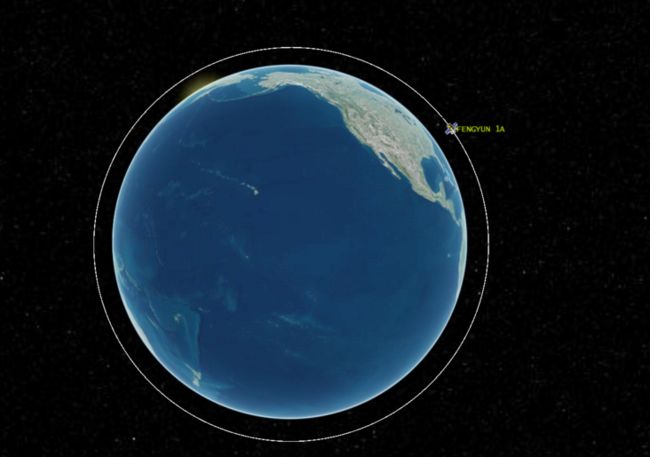背景:
本次需求基于实现卫星模型扫描地球的业务。
技术栈采用:
cesium 1.103.0
html
czml
记录:
1.卫星轨道数据获取
地址:https://www.space-track.org/#catalog
我这里选择获取fengyun的数据,可以得到一个TLE格式的两行数据

2.卫星轨道数据通用转换
因为有了tle数据,这里也选择去用sgp4来将数据转换成czml格式文件。
#!/usr/bin/python
# -*- coding:utf8 -*-
"""
本脚本根据TLE文件生成每颗卫星的CMZL文件,用于前端js使用Cesium显示卫星轨道
"""
# sgp4算法根据二行星历计算每个时间点卫星的位置
from sgp4.earth_gravity import wgs84
from sgp4.io import twoline2rv
import datetime
import json
# 按行读取北斗两行星历文件
# 每三行标识一个卫星,格式如下:
# FENGYUN 1A
# 1 19467U 88080A 23086.12932362 -.00000103 00000-0 -36906-4 0 9992
# 2 19467 99.1890 121.7932 0014370 10.7878 349.3593 14.03214030768865
# 星历下载地址:http://celestrak.com/
with open('fengyun.txt', 'r') as f:
data_lines = f.read().split('\n')
#TLE每颗卫星数据必须三行:第一行名称,后两行数据"
# 使用字典的数组(json文件)保存每颗卫星的轨道六根数
orbit_info = {}
# 每三行一组,遍历所有卫星
for j in range(len(data_lines) // 3):
# 第一行名字,后两行数据
# 数据详细说明:http://celestrak.com/columns/v04n03/
name = data_lines[j * 3].strip()
line1 = data_lines[1 + j * 3]
line2 = data_lines[2 + j * 3]
# 写轨道六根数到json文件
# print("卫星轨道倾斜角", line2[8:16], "度")
# print("升交点赤经", line2[17:25], "度")
# print("偏心率", line2[26:33])
# print("近地点角距", line2[34: 42], "度")
# print("平近点角", line2[43:51], "度")
# print("平均运动(每天绕地球圈数)", line2[52:63])
orbit_info.update({
name: {
'Inclination': line2[8:16],
'Right Ascension of the Ascending Node'.replace(' ', '_'): line2[17:25],
'Eccentricity': line2[26:33],
'Argument of Perigee'.replace(' ', '_'): line2[34: 42],
'Mean Anomaly'.replace(' ', '_'): line2[43:51],
'Mean Motion'.replace(' ', '_'): line2[52:63]
}
})
# 卫星每转1°所经历的时间(单位:秒)
gap = 1. / float(line2[52:63]) * 24 * 60 * 60 / 360
# 调用sgp4算法计算星历每个时刻的位置
satellite = twoline2rv(line1, line2, wgs84)
assert satellite.error == 0
# 记录当前时间,并在循环中计算出一个周期后的时间
# 用于在CZML文件中指定interval
now_time = datetime.datetime.now()
next_time = datetime.datetime.now()
# 保存每1°变化后卫星的位置(x, y, z):表示具体地心的距离(单位:km)
position_list = []
# 循环一圈
# 每次间隔gap秒
nums = 361
for i in range(nums):
# next_time表示每个位置对应的时间点
next_time = now_time + datetime.timedelta(seconds=gap * (i + 1))
# 表示为字典,方便propagate函数的计算
next_time_str = next_time.strftime('%Y %m %d %H %M %S').split(' ')
next_time_str = [int(v) for v in next_time_str]
time_key = ['year', 'month', 'day', 'hour', 'minute', 'second']
time_map = dict(zip(time_key, next_time_str))
# 调用sgp4库的propagate函数计算对应时刻的位置
position, velocity = satellite.propagate(
year=time_map['year'],
month=time_map['month'],
day=time_map['day'],
hour=time_map['hour'],
minute=time_map['minute'],
second=time_map['second']
)
# The position vector measures the satellite position in kilometers from the center of the earth.
# CZML文件中position的格式为:(time, x, y, z, time, x, y, z...)
position_list.append(next_time.isoformat())
position_list.append(position[0] * 1000)
position_list.append(position[1] * 1000)
position_list.append(position[2] * 1000)
# 格式化为ISO时间标准格式
begin = str(now_time.isoformat())
end = str((next_time + datetime.timedelta(seconds=gap)).isoformat())
# Write the CZML document to a file
filename = "D:/test/{}.czml".format(name)
# 初始化CZML
# CZML实际上是JSON文件,JSON文件就是字典数组
# 所以使用字典数据结构表示每个卫星
doc = []
# 定义头部
header = {
# id和version为固定格式
'id': "document",
"version": "1.0",
'name': name,
"clock": {
# interval为有效时间,currentTime表示起始点,multiplier表示时钟速度
"interval": '{}/{}'.format(begin, end),
"currentTime": begin,
"multiplier": gap
}
}
doc.append(header)
# 定义主体
body = {
"id": "satellites/{}".format(name),
"availability": '{}/{}'.format(begin, end),
"label": {
# 使用label显示卫星名字
"font": "11pt Lucida Console",
"outlineWidth": 2,
"outlineColor": {"rgba": [0, 0, 0, 255]},
"horizontalOrigin": "LEFT",
"pixelOffset": {"cartesian2": [12, 0]},
"fillColor": {"rgba": [213, 255, 0, 255]},
"text": name
},
"path": {
# path定义轨道的样式
"material": {
"polyline": {
"color": {
"rgba": [255, 0, 255, 255]
}
}
},
"width": 1,
"resolution": 120
},
"billboard": {
# 卫星的图标,使用base64编码表示图片
"image": "data:image/png;base64,iVBORw0KGgoAAAANSUhEUgAAABAAAAAQCAYAAAAf8/9hAAAAAXNSR0IArs4c6QAAAARnQU1BAACxjwv8YQUAAAAJcEhZcwAADsMAAA7DAcdvqGQAAADJSURBVDhPnZHRDcMgEEMZjVEYpaNklIzSEfLfD4qNnXAJSFWfhO7w2Zc0Tf9QG2rXrEzSUeZLOGm47WoH95x3Hl3jEgilvDgsOQUTqsNl68ezEwn1vae6lceSEEYvvWNT/Rxc4CXQNGadho1NXoJ+9iaqc2xi2xbt23PJCDIB6TQjOC6Bho/sDy3fBQT8PrVhibU7yBFcEPaRxOoeTwbwByCOYf9VGp1BYI1BA+EeHhmfzKbBoJEQwn1yzUZtyspIQUha85MpkNIXB7GizqDEECsAAAAASUVORK5CYII=",
"scale": 1.5
},
"position": {
# cartesian的格式:(time, x, y, z, time, x, y, z...)
"referenceFrame": "FIXED", # 可以取FIXED和INERTIAL表示固定和惯性参考系
# 插值填补轨道
"interpolationDegree": 5,
"interpolationAlgorithm": "LAGRANGE",
"epoch": begin,
"cartesian": position_list
}
}
# 在body中添加position
doc.append(body)
# 使用JSON写CZML文件
with open(filename, 'w') as f:
json.dump(doc, f)
原创作者地址:https://segmentfault.com/u/yourena_c
3.cesium加载卫星轨道数据
Cesium CZML Example
后续添加gltf卫星模型和扫描效果
